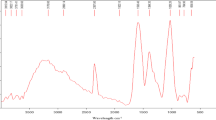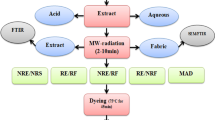Abstract
Indians are known as precursors in natural dyeing art. Even though home-grown knowledge mode has been experienced in the past over the years but applications of natural colourants have been reduced due to lack of methodical knowledge of extraction, dyeing procedures and documentation over generations. This leads to failure to commercialisation of natural colourants. All the synthetic colourants being used for dyeing textiles now a days have dire environmental concerns due to their toxicity and non-biodegradability. They generate water pollution, are carcinogenic along with waste disposal problems. Natural colourants are rational solution to all these problems. Thus, it is obligatory to evolve suitable technology for extraction and sustainable applications of natural dyes on textiles. Present study is an approach to extract natural colourants from a variety of plants sources such as Kalanchoe-pinnata, papaya, peepal and banyan using specific extraction techniques to achieve maximum yield in K/S and antioxidant properties. These four natural extracts were tested for their dyeing potential on wool fabric. Dyeing was performed using three different mordanting techniques (pre, meta and post-mordanting) wherein different natural mordants such as harda, amla, pomegranate and orange as well as synthetic mordants such as alum, copper sulphate and ferrous sulphate were used to fix dye on to the textile substrates. A rainbow of natural colours was obtained with varied shades of each colour. Finding of the study shows that all the four natural extracts give satisfactory wash and light colour fastness. The natural mordants give comparable results with synthetic mordants. Thus these natural extracts along with natural mordants can be explored at industrial scale for sustainable colouration of wool.
Access this chapter
Tax calculation will be finalised at checkout
Purchases are for personal use only
Similar content being viewed by others
References
Siva R (2007) Status of natural dyes and dye-yielding plants in India. Curr Sci 92:916–925
Ali NF, El-Mohamedy RSR, El-Khatibl EM (2011) Antimicrobial activity of wool fabric dyed with natural dyes. Res J Text Appeal 15:1–10. https://doi.org/10.1108/RJTA-15-03-2011-B001
Ali NF, El-Mohamedy RSR, Rajput S (2013) Improvement of antimicrobial activity for onion natural dyed fabrics through chitosan pretreatment. J Appl Sci Res 9:4993–5002
Nayak R, Thang Nguyen LV, Panwar T, Jajpura L (2020) Sustainable technologies and processes adapted by fashion brands. In: Nayak R (ed) Sustainable technologies for fashion and textiles. Woodhead Publishing, pp 233–248
Jajpura L (2018) Enzyme: a bio catalyst for cleaning up textile and apparel sector. In: Muthu SS (ed) Detox fashion, sustainable chemistry and wet processing. Springer Nature Singapore Pte Ltd, Singapore, pp 95–137
Jajpura L (2019) Biotechnology applications in textiles. In: Ul-Islam S, Butola BS (ed) Advanced functional textiles and polymers. Wiley, pp 99–127
Jajpura L, Rangi A, Khandual A (2020) Natural finishes, technologies and recent developments. In: Nayak R (ed) Sustainable technologies for fashion and textiles. Woodhead Publishing, pp 209–229
Jaipura L, Harad A, Maitra S (2006) Chitin and chitosan in antimicrobial composite fibres. Asian Text J 15:55–58
Rangi A, Jajpura L(2017) Guggul gum a biopolymer finishing agent for textiles. In: International conference on textile and clothing-present and future trends (TCPFT-2017), Calcutta, pp 91–94
Rangi A, Jajpura L (2015) The biopolymer sericin: extraction and applications. J Text Sci Eng 05:1–5
Jajpura L, Saini M, Rangi A (2016) Development of herbal mosquito repellent textiles using essential oils of pine, guggul and rosewood. Colourage 44–48
Jajpura L, Saini M, Rangi A, Chhichholia K (2015) A review on mosquito repellent finish for textiles using herbal extracts. Int J Eng Sci Manag 2:16–24
Samanta AK, Agarwal P (2009) Application of natural dyes on textiles. Indian J Fibre Text Res 34:384–399
Mahesh S, Reddy AHM, Vijaya KG (2011) Studies on antimicrobial textile finish using certain plant natural product. In: International conference on advances in biotechnology and pharmaceutical sciences (ICABPS’2011), Bangkok, 23–24 Dec 2011, pp 253–258
Chengaiah B, Rao KM, Kumar KM, Aagusundaram M, Chetty CM (2010) Medicinal importance of natural dyes—a review. Int J PharmTech Res 2:144–154
Calis A, Celik GY, Katircioglu H (2009) Antimicrobial effect of natural dyes on some pathogenic bacteria. Afr J Biotechnol 8:291–293
Villano D, Fernandez-Pachon MS, Moya ML, Troncoso AM, Parrilla MCG (2007) Radical scavenging ability of polyphenolic compounds towards DPPH free radical. Talanta 230
Jajpura L, Paul S, Rangi A (2016a) Sustainable dyeing of cotton with pomegranate rind in conjunction with natural mordant and biopolymer chitosan. Man Made Text India 44:180
Jajpura L, Paul S, Rangi A (2016b) Application of chitosan to impart antibacterial property to annatto dyed fabric. Asian Reson 5:99–105
Jajpura L, Paul S, Rangi A (2017) Dyeing of cotton with terminalia Chebula as natural dye with chitosan. Asian Dye 14:57–62
Pulipati S, Babu PS, Naveena U, Parveen SKR, Nausheen SKS, Sai MTN (2017) Determination of total phenolic, tannin, flavonoid contents and evaluation of antioxidant property of Amaranthus tricolor (L). Int J Pharmacogn Phytochem Res 814–819
Rani N, Tanwar P, Jajpura L (2017) Eco fashion by application of tagetes erecta flowers waste on sustainable textile material. Asian Reson 6:31–36
Jajpura L, Rimika, Rani N (2018) Sustainable dyeing of cotton fabric with eucalyptus erthrocorys leaves extract and natural mordant. Period Res 6:135–140
Rani N, Jajpura L, Butola BS (2017) Extract optimisation for natural herb Kalanchoe-Pinnata. J Basic Appl Eng Res 4:44–48
Rangi A, Jajpura L (2017) Effect of MLR, temperature and solvent on the extraction of colouration from arjun (Terminalia Arjuna) bark. J Agroecol Nat Resour Manag 4:87–89
Rani N, Jajpura L, Butola BS (2017a) Antimicrobial and antioxidant behavior of natural dye extracted from Kalanchoe pinnata. In: International conference on textile and clothing-present and future trends (TCPFT-2017), Calcutta, pp 94–99
Lalas S, Tsaknis J (2002) Extraction and identification of natural antioxidant from the seeds of the Moringa oleifera tree variety of Malawi. J Am Oil Chem Soc 677–683
Thakare VN, Suralkar AA, Deshpande AD, Naik SR (2010) Stem bark extraction of Ficus benghalensis Linn for anti-inflammatory and analgesic activity in animal models. Indian J Exp Biol 39–45
Nabawia AA, Moselhey MTH, Guirguis OW (2018) Study the effect of different dyeing conditions of extracted natural dye from leaves of neem on silk fabrics. J Chem Metrol 34–58
Author information
Authors and Affiliations
Corresponding author
Editor information
Editors and Affiliations
Rights and permissions
Copyright information
© 2021 The Editor(s) (if applicable) and The Author(s), under exclusive license to Springer Nature Singapore Pte Ltd.
About this paper
Cite this paper
Rani, N., Jajpura, L. (2021). Sustainable Dyeing of Wool by Natural Dyes in Conjunction with Natural Mordants. In: Midha, V., Mukhopadhyay, A. (eds) Recent Trends in Traditional and Technical Textiles. Springer, Singapore. https://doi.org/10.1007/978-981-15-9995-8_12
Download citation
DOI: https://doi.org/10.1007/978-981-15-9995-8_12
Published:
Publisher Name: Springer, Singapore
Print ISBN: 978-981-15-9994-1
Online ISBN: 978-981-15-9995-8
eBook Packages: Chemistry and Materials ScienceChemistry and Material Science (R0)




